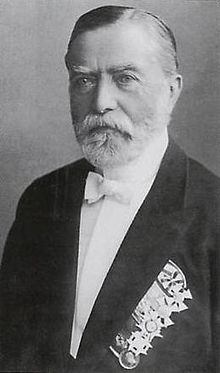Organ landscape Brandenburg
The Brandenburg organ landscape comprises around 2000 organs from the 17th to the 21st century.
territory
The organ landscape comprises the former province of Brandenburg , today the states of Brandenburg and Berlin . These include Niederlausitz , which only came to Prussia from Saxony in 1815, and Neumark , which has largely belonged to Poland since 1945.
history
The oldest mentions of organs in Frankfurt (Oder) and Altlandsberg as well as representations in Fürstenwalde (and Havelberg) are from the 14th century . The oldest surviving instrument made by an organ builder Werner from Brandenburg from this period is preserved as a case in Stockholm. All city churches probably had organs in the 15th century.
The famous north German organ builder Arp Schnitger worked for some time in Berlin at the beginning of the 18th century. He built several organs and was appointed royal court organ builder in 1708. Soon after, however, he turned away from Prussia. His student Johann Michael Röder then worked in the market for a few years.
He was ousted around 1720 by Joachim Wagner , who created organs at the highest level in Berlin and could be compared with Schnitger and his presumed teacher Gottfried Silbermann. He shaped organ building in the Brandenburg region for over 30 years and created over 50 organs , some of which have been preserved.
His students Gottlieb Scholtze in Neuruppin and Peter Migendt in Berlin continued his tradition. His colleague Ernst Marx then worked in Berlin, as did Johann Simon Buchholz .
In Niederlausitz, which at that time still belonged to Saxony, Carl Gotthold Claunigk and Johann George Gast were the most important organ builders.
The most important organ builder from the Brandenburg region of the early 19th century was Carl August Buchholz in Berlin. In addition, Ferdinand Dinse and his sons, Gottlieb Heise in Potsdam, Friedrich Hermann Lütkemüller in Prignitz, Friedrich Kienscherf in Eberswalde and others worked. Wilhelm Sauer developed into the most productive organ builder in the Mark since 1859, who also built several hundred organs in neighboring areas. Alexander Schuke also set up a larger production facility in Potsdam. In the early 20th century, organs were manufactured in large numbers, mostly on an industrial scale. Foreign companies such as Walcker , Steinmeyer and others also built in the Mark Brandenburg.
After 1945 the Schuke and Sauer companies developed into the largest in the GDR. Arno Voigt also worked in Bad Liebenwerda, Karl Gerbig and, after him, Ulrich Fahlberg in Eberswalde and Ludwig Glöckner in Berlin in the Brandenburg districts of Potsdam, Frankfurt (Oder) and Cottbus as well as Berlin (East) . The companies Jehmlich from Dresden and Eule from Bautzen also built organs in Brandenburg.
Karl Schuke founded a workshop in West Berlin in 1953 and became the most important organ builder there, and later Roman Ilisch was also self-employed.
After 1990 some new organs were built in the new state of Brandenburg, among others by the local companies Schuke, Sauer and Voigt. Smaller companies such as the Eberswalder Orgelbauwerkstatt , Christian Scheffler from Waldsieversdorf and Mike Zuber from Frankfurt (Oder) soon devoted themselves mainly to the restoration and maintenance of the preserved historical organs.
Organs
There are around 1,500 organs in Brandenburg and around 500 in Berlin.
The historically most important is the Wagner organ in the Brandenburg Cathedral from 1725, which has been preserved almost unchanged, other organs from him are in Angermünde , Treuenbrietzen , Wusterhausen / Dosse and Jüterbog as well as in other places. The oldest partially preserved instrument in Brandenburg is a positive from Christoph Werner in the Nikolaikirche Jüterbog from 1657, also partially preserved is the organ from Christoph Donat in Luckau from 1672. The oldest preserved organ from a Brandenburg organ builder is in Övertorneå in Sweden by Paul Müller from 1609, the organ case of a Werner von Brandenburg from 1370 in Stockholm today is the oldest surviving one. The largest organ in the organ landscape is at the Berlin Cathedral of Wilhelm Sauer with 112 registers , the theater organ Mighty Wurlitzer in the Music Instrument Museum Berlin has 145 registers.
literature
Overview representations
- Wolf Bergelt : Organ tours through the Mark Brandenburg. Freimut & Selbst, Berlin 2005, ISBN 3-7431-5217-7 .
- Wolf Bergelt: The Mark Brandenburg. A rediscovered organ landscape. Pape, Berlin 1989, ISBN 3-921140-32-3 .
Organ builder
- Uwe Pape , Wolfram Hackel, Christhard Kirchner (Ed.): Lexicon of North German Organ Builders . Volume 4. Berlin, Brandenburg and the surrounding area. Pape Verlag, Berlin 2017.
Web links
- The organ landscape of the State of Brandenburg by Christhard Kirchner, historical overview (PDF)
- Institute for Organ Research homepage, with links to history and a.
Individual evidence
- ^ Wolf Bergelt : Organ tours through the Mark Brandenburg. Freimut & Selbst, Berlin 2005, ISBN 3-7431-5217-7 ; also in the 18th century institute for organ research.
- ↑ The organ landscape of the state of Brandenburg by Christhard Kirchner, historical overview (PDF).


